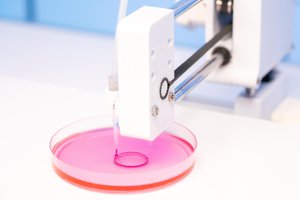
Sandra’s research focusses on the development of photo-crosslinkable (bio)polymers and their processing capabilities using 3D printing techniques. Over the last 15 years, she has led the synthesis, modification and processing of a variety of (bio)polymers including thermoplasts and hydrogels in the field of regenerative medicine.
In this interview with Rousselot, Sandra shares her expertise on boosting research by using the right gelatin-based biomaterials for the research project, and the process of developing a new material from an initial concept all the way towards clinical translation.
Read on to learn more!
How do you choose the right biomaterial for your application?

“Choosing the right biomaterial begins with a thorough understanding of the project and its specific requirements. In our research group, where we invest a lot of time in light-based 3D printing, this is essential because the material influences the resolution of the printing process.
We determine the functional requirements of the biomaterial – for example, does it need to be strong, flexible or soft? What is the desired biodegradation timeline? Is there a need for cell encapsulation, or will cells be seeded?
We also assess the cost associated with modification, as well as the availability of functionalization agents and the shelf life of the derivative. Sometimes a more expensive, high-quality material is the best choice due to its longer lifespan or better printability, but it must be balanced with the budget.
Finally, we consider the sustainability and environmental friendliness of the material – this is becoming increasingly important in our choices.”
What is the origin of GelMA?

“Gelatin Methacryloyl (GelMA) was first synthesized and patented in 1997 by An Van Den Bulcke during her PhD research in the Polymer Chemistry and Biomaterials research group founded by Prof. Etienne Schacht at Ghent University. The development of GelMA involves chemically modifying gelatin so that it acquires photo-crosslinkable properties and can maintain its shape at 37°C, making it useful for biomedical applications.
The first publication on Gelatin Methacryloyl (GelMA) by An Van Den Bulcke et al. appeared in the journal Biomacromolecules in 2000. This groundbreaking study had a major impact in the field of tissue engineering and biomedical applications. According to recent counts, the original article has received over 1,800 citations, highlighting its significant impact within the scientific community. Today, GelMA is widely used due to its biocompatibility and versatility, especially in applications like 3D bioprinting and regenerative medicine.”
When do you use gelatin in your research?
“If cell-interactive properties are required, we always use a gelatin derivative, either as a starting material for 3D printing, as a coating on a medical device or as a construct with superior mechanical properties.
Gelatin is an ideal starting material, can be easily functionalized, and has already been approved for various clinical applications
Thanks to its unique properties, it forms an ideal matrix to mimic the natural environment of living cells.”

What is the process of developing a new biomaterial?

“This usually begins with a specific question or need within a project. This challenge often arises from the limitations of existing materials or the desire to create a product with unique properties that have not yet been realized. We review existing literature to understand what is already available and identify any gaps. A team of chemists, engineers, cell biologists, and clinicians work together to define the desired properties of the new biomaterial. This may involve experimenting with different compositions, polymers or natural ingredients.
Once the design concept is clear, we move to developing and testing small quantities of the biomaterial. We adjust the formulation based on test results until the material meets the specified requirements. Finding the right biomaterial in the early stages of product development can mean we’ve created an innovative solution that is a step ahead of the competition.”
What is your experience with the market adoption & translation of new materials to clinical applications?
“Developing an innovative biomaterial is only the first step; the real challenge lies in translating this material into a commercially viable product that meets the stringent requirements of the clinical environment.
At BIO INX, the spin-out company from Ghent University and the Vrije Universiteit Brussel, we have experienced these challenges firsthand. BIO INX focuses on the development of bio-inks for 3D printing, which is a promising technology for creating customized implants and tissues. Here, the focus is not only on the technical performance of the materials but also on their biocompatibility and safety, which are essential for clinical approval

Successfully achieving clinical translation that complies with regulatory agencies like the FDA or EMA requires a deep understanding of materials and their interaction with the human body. Meeting these standards ensures that innovative materials are not only safe but also effective in clinical settings, ultimately improving patient care.”
